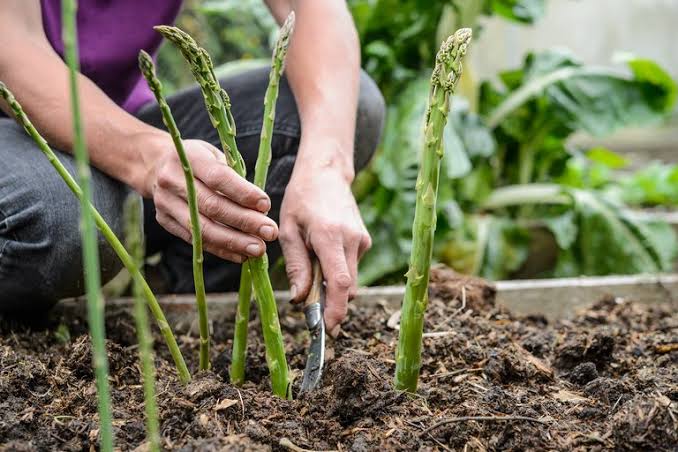Asparagus is one of those vegetables that feels both timeless and gourmet. Whether you love it roasted with olive oil and sea salt or dressed up in a creative recipe, asparagus brings elegance and nutrition to the table. But what if you could grow your own? Learning how to plant asparagus is easier than you might think—and it’s a long-term investment in your garden.Asparagus is a perennial vegetable, meaning once you plant it, it will keep producing year after year. In fact, a well-maintained asparagus bed can provide delicious spears for 15–20 years! Whether you go with the classic approach to planting or get a little creative with your garden design, asparagus works beautifully both ways.🌱 Why Grow Asparagus at Home?Before diving into the process, let’s explore why asparagus deserves a spot in your garden:Fresh Flavor: Homegrown asparagus is far more tender and sweet than store-bought.Nutrient-Rich: Packed with fiber, folate, and vitamins A, C, and K.Perennial Payoff: Plant once, harvest for decades.Versatile in the Kitchen: Perfect for classic dishes or creative twists.🛠️ What You’ll Need to Plant AsparagusGetting started doesn’t require much—just a few essentials:Asparagus crowns (1-year-old roots are ideal) or seedsWell-draining soil rich in organic matterCompost or aged manureA shovel and garden forkMulch for moisture retentionPatience (asparagus takes 2–3 years to fully establish)👌 Step-by-Step: How to Plant Asparagus the Classic WayStep 1: Choose the Right LocationAsparagus loves full sun (6–8 hours daily).Pick a spot where it can grow undisturbed for years.Step 2: Prepare the SoilLoosen soil with a garden fork to about 12–18 inches deep.Mix in compost or aged manure to enrich the soil.Step 3: Dig TrenchesDig trenches about 6–8 inches deep and 12 inches wide.Space trenches about 3 feet apart if planting multiple rows.Step 4: Plant the CrownsPlace asparagus crowns in the trench, roots spread out like a fan.Cover with 2 inches of soil, leaving the rest for gradual filling as the plant grows.Step 5: Water and WaitWater well after planting.As shoots emerge, add more soil gradually until the trench is filled.🌿 Creative Ways to Plant AsparagusWhile the classic trench method is most common, there are creative ways to make asparagus planting unique and stylish:1. Raised Bed PlantingPlant asparagus in raised beds for easier maintenance and improved drainage.Perfect for small gardens or urban spaces.2. Companion PlantingPair asparagus with herbs like basil or parsley to deter pests.Tomatoes also make great companions, creating a lush, productive garden bed.3. Decorative Garden DesignAsparagus ferns grow tall and feathery—use them as a backdrop in your garden for visual appeal.Works beautifully in mixed ornamental and edible landscapes.4. Patio or Container GrowingWhile less common, asparagus can grow in deep containers with good soil.Ideal for small patios or balcony gardeners.🌟 Tips for a Successful Asparagus PatchBe Patient: Don’t harvest until year 2 or 3 to allow plants to establish strong roots.Mulch Generously: Helps retain moisture and suppress weeds.Feed Annually: Add compost or fertilizer each spring.Weed by Hand: Avoid disturbing shallow roots with hoes or rakes.Cut Ferns in Fall: Once foliage turns yellow, cut it down to ground level to prepare for winter.🍴 Cooking Inspiration: Classic vs. Creative Asparagus RecipesGrowing asparagus is only half the fun—enjoying it in the kitchen is the reward!Classic IdeasRoasted asparagus with olive oil and garlicSteamed asparagus with hollandaise sauceAsparagus quiche or frittataCreative TwistsAsparagus pizza with goat cheese and caramelized onionsPickled asparagus for salads and charcuterie boardsAsparagus tempura for a crispy treatBy planting your own, you’ll always have fresh spears on hand for both timeless recipes and culinary experiments.❌ Common Mistakes to AvoidPlanting in poorly drained soil (causes root rot).Harvesting too soon (weakens the plant long-term).Crowding plants too close together.Forgetting to mulch, which leads to weeds competing for nutrients.🌿 Eco-Friendly Asparagus GardeningWant to keep your asparagus patch sustainable? Try these eco-friendly practices:Use organic compost instead of synthetic fertilizers.Water in the early morning to reduce evaporation.Reuse garden trimmings as mulch.Rotate with cover crops nearby to improve soil health.ConclusionWhen it comes to asparagus, both classic and creative methods of planting work beautifully. Whether you stick to the tried-and-true trench approach or experiment with raised beds, companion planting, or decorative garden layouts, asparagus will reward you with years of harvests.Growing your own asparagus is more than just gardening—it’s an investment in fresh flavor, nutritious meals, and a greener lifestyle. So grab your crowns, prepare your soil, and start today. With patience and care, you’ll impress your friends and family with homegrown asparagus that’s as delicious as it is stylish. 🌱🥘

